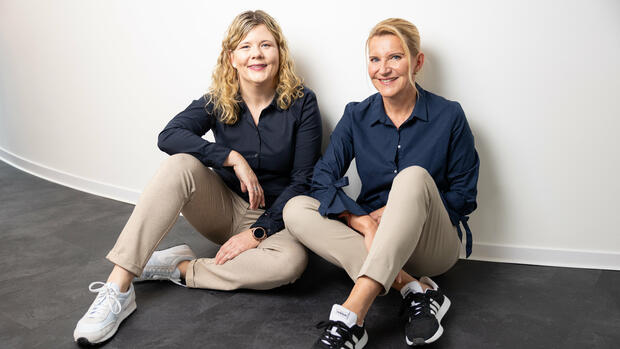Stuttgart Brain tumor surgeries require extreme precision. Every little wrong move by the operator can mean additional damage to the patient’s brain. So far, surgeons have been left alone with this problem. They often have to stand bent over the patient for hours, and develop muscle or back problems themselves. Sabrina Hellstern and Claudia Sodha want to change that.
The two founders of Hellstern Medical, together with doctors and engineers, have developed the world’s first sensor-controlled exoskeleton that supports surgeons during surgery.
Doctors put on an ergonomic carrying system attached to a metal frame like a backpack. The frame supports the bent upper body, the back is relieved. Thanks to sophisticated sensors and software, the system follows the operator in any desired position. At the same time, they have their hands free for the operation.
Operations that are life-threatening for patients often last many hours. Surgeons are exhausted and work in constrained, twisted postures. This can lead to muscle or skeletal disorders that impair performance in the long term. “By law, operators are entitled to an ergonomic workplace,” says Sabrina Hellstern. “But the reality is different.”
Many doctors take painkillers themselves to survive the day-to-day operations. Hellstern even speaks of 40 percent of all operating surgeons. With Claudia Sodha she has developed a different solution: the exoskeleton. The founders have already had their first financial successes; the device is used at the University Hospital in Tübingen, for example. But the investment is still high. The founders are now expanding their sales significantly.
The frame supports the bent upper body, the back is relieved. At the same time, the hands are free for the operation.
(Photo: Hellstern medical)
“We have already successfully completed the first heart operation,” says Hellstern. She worked for years in sales for medical technology, maintains good contacts in the clinics and knows the needs on site. “Doctors asked us whether something like this could be developed,” says Hellstern. One of them is the head of the Tübingen children’s neurosurgery, Martin Schuhmann. He counts himself among the pain-stricken victims of the working conditions and is part of the Hellstern founding team of six people.
Medical technology for the operating room: Exoskeleton is patented worldwide
Relief for doctors like Schuhmann during operations has been overdue for decades, says Hellstern. The prototype called “Noac” was created all the faster: According to the founders, the device was developed in just 15 months together with two engineers and two surgeons. It is now patented worldwide and certified as a medical product.
Operators put on the straps like a backpack and are supported by the metal frame. This relieves the back during hours of surgery.
(Photo: Hellstern medical)
Some of the Noac components were created by the machine builder Brecht in the small Wannweiler industrial park between Reutlingen and Tübingen. The carrying system was developed by backpack specialist Deuter. “The name is an abbreviation for ‘no ache’ – no pain,” explains founder Hellstern.
When the 40-year-old talks about the working conditions in the OR, she comes across as speaking from her own experience as a doctor. To start the project four years ago, the mother of two even sold the family car and mortgaged her house.
“This step was never up for discussion for me,” she explains. “When I look back at 80, that personal risk will seem tiny compared to having solved a huge problem and thereby saved lives.”
Hellstern Medical: Next round of financing is underway
Its co-founder, Claudia Sodha, is responsible for finances as CFO. The 59-year-old is an engineer and experienced management consultant. In 2021, Hellstern Medical closed a seed financing of 3.3 million euros.
The two entrepreneurs also won the Baden-Württemberg Founder’s Prize in 2019. The next round of financing is now running for a further three million euros. The money is needed for sales development at home and abroad.
>> Read also: Phillips prepares market launch of its AI platform for radiology
Hellstern and Sodha are currently in a different clinic almost every day to have their first series-ready device tried out by surgeons. Because the demand has to come from the OP. Clinics only order such new devices under pressure from their doctors. “There are already numerous interested parties,” Hellstern assures.
For example, Noac is already being used at the University Hospital in Tübingen. Volker Steger, specialist in heart surgery and head of thoracic surgery in Tübingen, says: “I had to let go of a disc. A support system would not only help me, it would also be a competitive advantage for the clinic.” His colleagues Silvio Nadalin, Head of the Transplant Center, or Sara Y. Brucker, Medical Director in the Department of Women’s Health, are already actively using the exoskeleton in the operating room.
Surgeons are exhausted and often work for hours in constrained, twisted postures. The founders want to change that.
(Photo: Hellstern medical)
How big the success on the market will be remains to be seen. After all, the operations have to be long enough for a clinic to make the purchase worthwhile. Because the exoskeleton is not cheap. The devices will cost between 80,000 and 100,000 euros. In order to make the decision easier for the clinic operators, they can also be leased for 1500 euros per month.
“We want to earn enough money with Noac so that we can finance our next idea,” says Sabrina Hellstern. And the founder has plenty of other ideas to make the work of doctors easier: “I would like to help cerebral autoregulation measurement achieve a breakthrough.” That means she wants to improve the monitoring and control of the oxygen supply to the brain during operations. “Our ultimate goal is to save lives,” she emphasizes.
More: “Iron Man’s” little brother – German Bionic wants to bring exoskeletons to the mass market.
